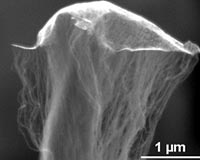 |
Lincoln NE (SPX) Sep 23, 2009 Does theory lead experiments or do experiments lead theory? Scientists know the correct answer is that interplay between theory and experiments result in new advances. At times, experiment and technological development pave the way for theory. At other times, successful theory can contribute substantially to interpretation and analysis of the experimental data. But even more important is when theory can predict new effects and lead to new experiments and developments. This is evident in the new work at the University of Nebraska-Lincoln Materials Research Science and Engineering Center published in the scientific journal Nano Letters. Three years ago, theoretical work of a research group of UNL physics and astronomy professor Evgeny Tsymbal predicted a new effect that could revolutionize the field of microelectronics by allowing faster, smaller and more energy-efficient memory devices. Recently, measurements of the electrical properties of ferroelectric materials performed at the Alexei Gruverman lab led to experimental verification of the predicted behavior. In their paper published online in Nano Letters, Gruverman, an associate professor of physics and astronomy, and Tsymbal, with co-authors demonstrated a several-orders-of-magnitude change in electrical resistance upon flipping of polarization in ultra-thin ferroelectric films. Because of their ability to retain permanent electric polarization in the absence of the electric field, for decades ferroelectrics have been the subject of intense development for use in nonvolatile memory, where tiny bits of information are stored as polarization dipoles oriented up and down. The effect discovered at the UNL center could help overcome one of the most serious problems related to miniaturization of charge-based memory technologies ��� reduced charge and increasing leakage current ��� that leads to larger power consumption and progressive loss of stored information. In fact, it can turn this problem into an advantage because it will allow nondestructive read-out of the polarization state of the film simply by measuring its electrical resistance, which can be performed at a significantly lower voltage. Application of the advanced measurements techniques showed that a single bit of information can be as small as 20 nanometers in diameter (1/1000th diameter of a human hair). The ferroelectric films for this study were grown by collaborators at the University of Wisconsin, Madison. Funding from the National Science Foundation helps support this research. Share This Article With Planet Earth
Related Links University of Nebraska-Lincoln Nano Technology News From SpaceMart.com Computer Chip Architecture, Technology and Manufacture
 Rice Scientists Use Nanomaterials To Grow Flying Carpets
Rice Scientists Use Nanomaterials To Grow Flying CarpetsHouston TX (SPX) Aug 03, 2009 With products that range from carpets to kites, you'd think Rice University chemist Bob Hauge was running a department store. What he's really running is a revolution in the world of carbon nanotechnology. In a paper published this month in Nano Research, Hauge's Rice University team describes a method for making "odako," bundles of single-walled carbon nanotubes (SWNT) named for the ... read more |
|
| The content herein, unless otherwise known to be public domain, are Copyright 1995-2009 - SpaceDaily. AFP and UPI Wire Stories are copyright Agence France-Presse and United Press International. ESA Portal Reports are copyright European Space Agency. All NASA sourced material is public domain. Additional copyrights may apply in whole or part to other bona fide parties. Advertising does not imply endorsement,agreement or approval of any opinions, statements or information provided by SpaceDaily on any Web page published or hosted by SpaceDaily. Privacy Statement |